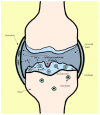Potential Mechanism of Action of Current Point-of-Care Autologous Therapy Treatments for Osteoarthritis of the Knee-A Narrative Review
- PMID: 33800401
- PMCID: PMC7962845
- DOI: 10.3390/ijms22052726
Potential Mechanism of Action of Current Point-of-Care Autologous Therapy Treatments for Osteoarthritis of the Knee-A Narrative Review
Abstract
Osteoarthritis (OA) is a progressive degenerative disease that manifests as pain and inflammation and often results in total joint replacement. There is significant interest in understanding how intra-articular injections made from autologous blood or bone marrow could alleviate symptoms and potentially intervene in the progression of the disease. There is in vitro an in vivo evidence that suggests that these therapies, including platelet-rich plasma (PRP), autologous anti-inflammatories (AAIs), and concentrated bone marrow aspirate (cBMA), can interrupt cartilage matrix degradation driven by pro-inflammatory cytokines. This review analyzes the evidence for and against inclusion of white blood cells, the potential role of platelets, and the less studied potential role of blood plasma when combining these components to create an autologous point-of-care therapy to treat OA. There has been significant focus on the differences between the various autologous therapies. However, evidence suggests that there may be more in common between groups and perhaps we should be thinking of these therapies on a spectrum of the same technology, each providing significant levels of anti-inflammatory cytokines that can be antagonists against the inflammatory cytokines driving OA symptoms and progression. While clinical data have demonstrated symptom alleviation, more studies will need to be conducted to determine whether these preclinical disease-modifying findings translate into clinical practice.
Keywords: autologous anti-inflammatory; concentrated bone marrow aspirate; intra-articular injection; mechanism of action; osteoarthritis; platelet-rich plasma.
Conflict of interest statement
J.W.-M. and K.S. are paid employees of Zimmer Biomet and W.K. is a paid employee of Owl Manor.
Figures



Similar articles
-
Efficacy of intra-articular injections of platelet-rich plasma as a symptom- and disease-modifying treatment for knee osteoarthritis - the RESTORE trial protocol.BMC Musculoskelet Disord. 2018 Jul 28;19(1):272. doi: 10.1186/s12891-018-2205-5. BMC Musculoskelet Disord. 2018. PMID: 30055602 Free PMC article.
-
Intra-articular Injections of Platelet-Rich Plasma Releasate Reduce Pain and Synovial Inflammation in a Mouse Model of Osteoarthritis.Am J Sports Med. 2018 Mar;46(4):977-986. doi: 10.1177/0363546517750635. Epub 2018 Jan 26. Am J Sports Med. 2018. PMID: 29373806
-
Multiple Platelet-Rich Plasma Injections Versus Single Platelet-Rich Plasma Injection in Early Osteoarthritis of the Knee: An Experimental Study in a Guinea Pig Model of Early Knee Osteoarthritis.Am J Sports Med. 2019 Aug;47(10):2300-2307. doi: 10.1177/0363546519856605. Epub 2019 Jul 3. Am J Sports Med. 2019. PMID: 31268737
-
Platelet-Rich Plasma for the Management of Hip and Knee Osteoarthritis.Curr Rheumatol Rep. 2017 May;19(5):24. doi: 10.1007/s11926-017-0652-x. Curr Rheumatol Rep. 2017. PMID: 28386761 Review.
-
Orthobiologics: Injectable Treatments for Knee Osteoarthritis.Clin Sports Med. 2025 Jul;44(3):401-413. doi: 10.1016/j.csm.2024.12.001. Epub 2025 Mar 14. Clin Sports Med. 2025. PMID: 40514146 Review.
Cited by
-
Platelet-Rich Plasma for Knee Osteoarthritis: What Does the Evidence Say?Drugs Aging. 2023 Jul;40(7):585-603. doi: 10.1007/s40266-023-01040-6. Epub 2023 Jun 22. Drugs Aging. 2023. PMID: 37347411 Review.
-
Mechanistic Insights and Real-World Evidence of Autologous Protein Solution (APS) in Clinical Use.Int J Mol Sci. 2025 Aug 5;26(15):7577. doi: 10.3390/ijms26157577. Int J Mol Sci. 2025. PMID: 40806704 Free PMC article.
-
Case Report: Rehabilitation After Platelet-Rich Growth Factors' Intra-Articular Injections for Knee Osteoarthritis: Two Case Reports of a Home-Based Protocol.Front Pharmacol. 2021 Aug 23;12:718060. doi: 10.3389/fphar.2021.718060. eCollection 2021. Front Pharmacol. 2021. PMID: 34497519 Free PMC article.
-
Individual immune cell and cytokine profiles determine platelet-rich plasma composition.Arthritis Res Ther. 2023 Jan 10;25(1):6. doi: 10.1186/s13075-022-02969-6. Arthritis Res Ther. 2023. PMID: 36627721 Free PMC article.
References
-
- Aigner T., Schmitz N. Pathogenesis and pathology of osteoarthritis. Rheumatology. 2011;7:1741–1759.
-
- Fernandes J.C., Martel-Pelletier J., Pelletier J.P. The role of cytokines in osteoarthritis pathophysiology. Biorheology. 2002;39:237–246. - PubMed
Publication types
MeSH terms
Substances
LinkOut - more resources
Full Text Sources
Other Literature Sources
Research Materials

